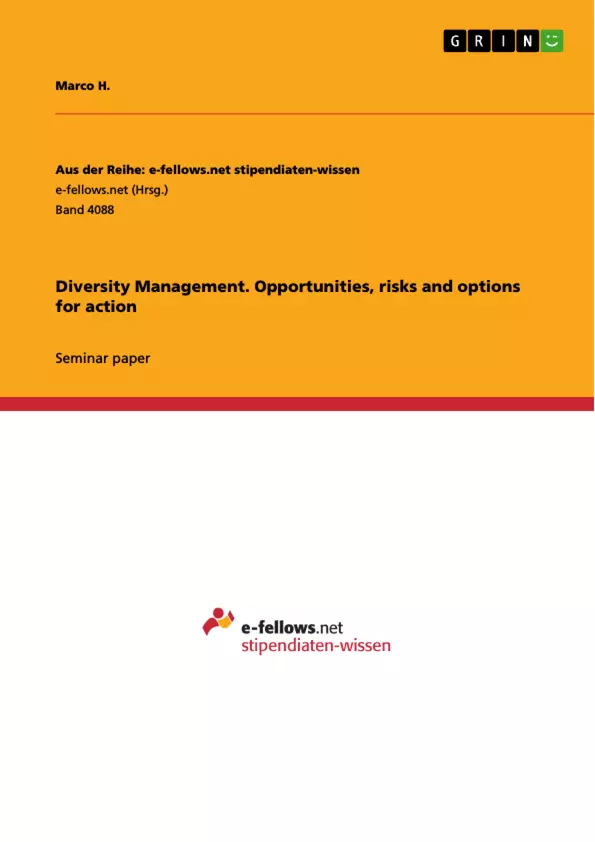In the course of the Internet and expanded transnational relationships, companies are increasingly acting globally and coming into contact with many cultures, so that diversity is also becoming essential within the corporate structure. In order to be able to react to all these changes flexibly and in line with the market, it is inevitable for companies to deal with diversity management (DiM).
The aim of this paper is to generate a comprehensive knowledge of DiM as such, to be able to rationally weigh opportunities and risks and to derive from this the various options for action of the respective dimensions of diversity.
know. In order to establish the knowledge base required for this purpose, chapter 2.1 deals with the terms diversity and management. Building on this, Chapter 2.2 outlines the opportunities and risks for companies associated with implementing the DiM concept.
With this background knowledge, the four-level model according to Gardenswatz and Rowe is presented in the following chapter 2.3 to illustrate the complex topic. In connection with the acquired knowledge of the different levels, chapter 2.4 switches to the operational level and presents concrete options for action within the framework of the DiM concept. In the conclusion, the findings are summarized, followed by a critical examination of the assignment. Finally, an outlook on possible changes is given.
Inhaltsverzeichnis (Table of Contents)
- Introduction
- Problem / Relevance
- Objective and structure
- Diversity Management (DiM)
- Definition of terms
- Diversity
- Diversity management
- Opportunities and risks of DiM for companies
- Opportunities
- Risks
- Levels of diversity
- Options for action and instruments
- Final part
- Conclusion
- Limitations
- Factors/ Outlook
Zielsetzung und Themenschwerpunkte (Objectives and Key Themes)
This term paper aims to provide a comprehensive understanding of Diversity Management (DiM), enabling a rational evaluation of its opportunities and risks. The paper focuses on exploring different dimensions of diversity and their respective options for action.
- Definition and understanding of Diversity and Diversity Management.
- Analysis of opportunities and risks associated with DiM implementation for companies.
- Exploration of various levels of diversity within organizations.
- Presentation of practical options for action and instruments within the framework of DiM.
- Critical evaluation of the assignment and outlook on future developments.
Zusammenfassung der Kapitel (Chapter Summaries)
- Introduction
- The chapter introduces the topic of Diversity Management (DiM) as a relatively new management concept with roots in the Anglo-Saxon area, tracing its development from the 1960s to the present.
- It emphasizes the growing relevance of DiM in today's society, highlighting demographic shifts, challenges in finding skilled workers, and changing societal values.
- The chapter outlines the objective and structure of the term paper, setting the stage for the subsequent analysis of DiM.
- Diversity Management (DiM)
- The chapter defines the key terms of diversity and diversity management, drawing on various academic perspectives.
- It explores the different dimensions of diversity, including perceptible differences like age, gender, and race, as well as subjective differences like lifestyle and values.
- The chapter provides a definition of diversity management as a strategic approach to leveraging existing human diversity for organizational success.
- Opportunities and Risks of DiM for Companies
- This chapter delves into the potential benefits and drawbacks of implementing DiM within companies.
- It highlights the opportunities presented by DiM, such as mitigating skilled worker shortages, fostering creativity and social competence, and enhancing market competitiveness.
Schlüsselwörter (Keywords)
This term paper focuses on the key concepts of diversity management, including diversity, human resource management, organizational orientation, opportunities, risks, levels of diversity, options for action, and instruments. It explores the application of these concepts within the context of organizational development and change management, aiming to provide a comprehensive understanding of the topic.
- Citation du texte
- Marco H. (Auteur), 2014, Diversity Management. Opportunities, risks and options for action, Munich, GRIN Verlag, https://www.grin.com/document/1168134



